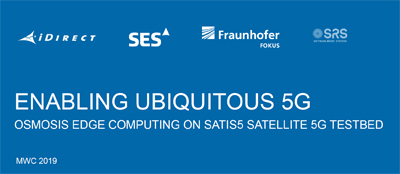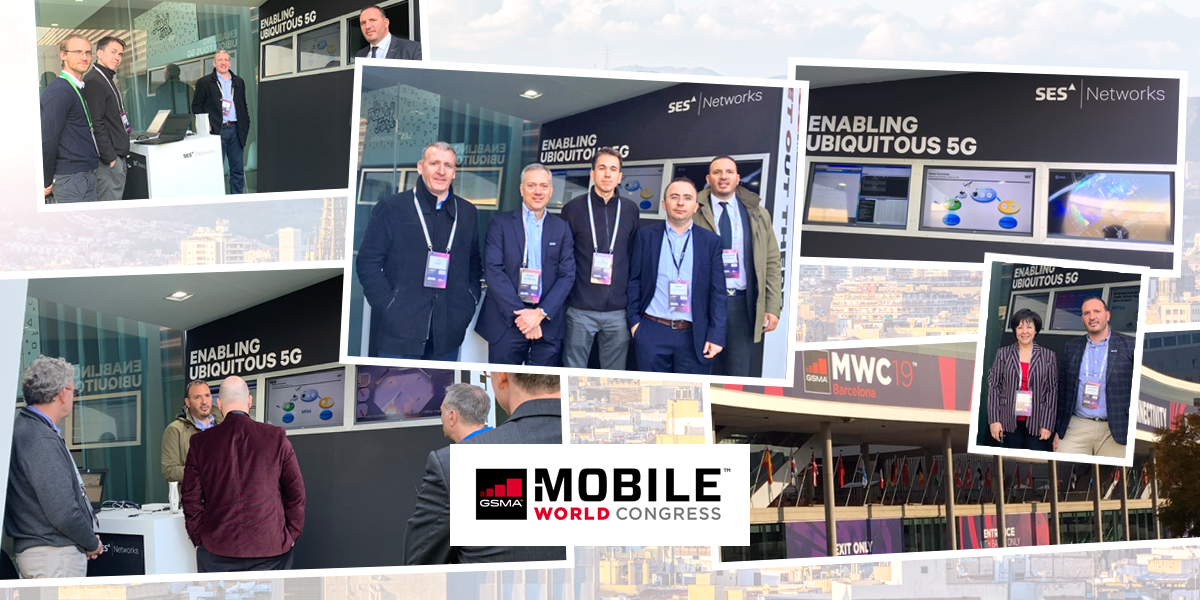A slew of demonstrations showing off 5G’s capabilities took place in Barcelona this week, thanks to satellites.
ESA’s Satellite for 5G Initiative works to promote the integration of space assets into the burgeoning 5G movement.
It supports trials and demonstrations showcasing how satellites can add reach, resiliency, security and capacity to terrestrial networks.
Several of these projects set up camp at the Mobile World Congress (MWC) from 25 to 28 February in central Barcelona, Spain.
The first, SATis5, showed how satellite ‘backhaul’ connectivity – linking small local networks to the main fibre spine – could be used to support a prototype 5G terrestrial network spread across Barcelona, Killarney in Ireland and Betzdorf in Luxembourg.
SATis5 is a 5G ‘testbed’, providing other projects with the infrastructure in which they can demonstrate satellite-enabled 5G applications.
The prototype system is based on the latest release of the 3rd Generation Partnership Project (3GPP) 5G core network, with live content distributed in real time via SES’s (LU) satellite capacity and cutting-edge terrestrial equipment at the three sites, based on the VT iDirect (UK) hub and infrastructure and the Fraunhofer FOKUS (DE) 5G technology.

In Barcelona, the SATis5 live content on display was developed under another ESA project: OSMOSIS.
OSMOSIS technology is specially designed to distribute mobile video content over a satellite network with 4G or 5G.
It is led by VT iDirect, and during its first proof of concept testing this week enabled visitors to the SATis5 testbed to experience multimedia content delivery to their smartphones and laptops via satellite-connected base stations, at 5G-like speeds and data rates.
Today, terrestrial networks often cannot cope with sudden surges in connectivity demands, for example during festivals or at sports events. Technologies like OSMOSIS cleverly combine cellular and satellite capabilities to optimise the network’s response to such traffic surges, ensuring efficiency and scalability for the future 5G ecosystem.
Proof of concepts like the SATis5 testbed and OSMOSIS are vital to establish that space can be leveraged to deploy 5G services regardless of location, network conditions or mobility requirements.
In fact, satellite-enabled 5G has a wide range of benefits, beyond the more commonly known media and entertainment uses.
Another of ESA’s partners, Hispasat (ES) and the 5G Barcelona consortium, used satellite-enabled 5G to simulate connected emergency healthcare, for example.
A model of an ambulance, equipped with 4G/5G connections and a satellite antenna, replicated the scenario of a patient with a collapsed lung being sped to hospital, with emergency medical personnel in the vehicle consulting specialists at a hospital via a two-way high-definition audio-visual connection.
It showed how in the future, specialists can monitor the patient’s status in real time from the second the patient is picked up, which can be key to their survival and subsequent recovery.
The satellite connection is important, as it will enable seamless content delivery both in urban areas with established 5G networks, and in areas with only a 4G connection or without any terrestrial networks at all. In those scenarios, the satellite will close the loop from space.
ESA’s Satellite for 5G Initiative has signed an agreement with the 5G Barcelona consortium to support exactly these kinds of innovative projects, as well as Letters of Intent with a wide range of European satcom companies and 5G centres, such as the VTT Finnish Technical Research Centre, who were also demonstrating various satcom 5G use cases at the conference.
Under the Letter of Intent, ESA and VTT plan to develop showcases for 5G-enabled autonomous shipping, self-driving cars and public safety. VTT had a number of demonstrations on display at MWC, including LuxTurrim5G, a case study on how smart city drones and 5G-equipped lampposts can help keep citizens safe.
Speaking as Business Finland’s MWC keynote speaker, Antonio Franchi, Head of ESA’s Satellite for 5G and Future Programmes Acquisition, said: “The depth of innovation and breadth of applications on display here in Barcelona is truly the best calling card for integrated satellite and terrestrial 5G networks.
“It is clear that 5G can only deliver on its promise of global, ubiquitous connectivity by harnessing space technology, and we at ESA intend to keep working with our partners to ensure the two evolve together to make that future a reality.”
